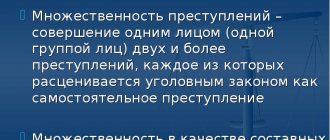I recently took a criminal law exam. I came across a question related to a rather complex and important concept: types of sanctions in criminal law. I failed the test because during the session I missed a lecture on the topic of disposition and sanctions in criminal law. When I fully understood this question, I realized how important it is to know the answer to it. In this note, I decided to share my new knowledge with you, I’ll tell you:
- What does disposition represent and where is it present in the provisions of criminal and civil law?
- What are sanctions in modern UP?
- What is the difference between dispositions and legal sanctions?
- What types of legal sanctions and categories of dispositions exist?
General concepts
Each theoretical section of modern law contains such a concept as “Established legal norm”.
Without this legal composition, the branch of legislation is not considered. Without knowledge regarding the disposition and what legal sanctions are in the Criminal Code, it is impossible to clearly and correctly explain the law, much less apply it in the practice of criminal law.
The modern legal norm of UE is:
- Legislative rules of individual behavior of a person and the whole society.
- Careful compliance with modern law and UP.
- Fulfillment by a person of his obligations.
Failure to comply with the rules of conduct will be punished strictly in accordance with the law!
The disposition of each modern article of the Criminal Code is an important part of the rules of generally accepted correct behavior prescribed in the legislation.
Criminal law through time
Having examined the concept and types of sanctions in criminal law, we should move on to a brief description of the norm itself. According to the law, the effect of any law is limited to a certain time frame. Thus, in law there is the concept of a statute of limitations. It does not affect the form of sanctions, but can completely eliminate the initiated case of committing a criminal act.
The question of when the crime was committed is also controversial. There are several points of view on this matter:
- a crime occurs from the moment socially dangerous consequences arise;
- the moment of commission of a criminal act is the direct implementation of an illegal action or inaction;
- If the perpetrator, having committed a crime, has the opportunity to correct everything, the beginning of the illegal act is considered to be either the moment of the onset of the consequences or the moment of commission of the illegal act.
Crimes are ongoing and ongoing. The first are characterized by a long-term failure of a person to fulfill his duties, and the second - by a number of identical acts.
The structure of behavioral standards
The theoretical part of modern criminal law has three important components:
- A hypothesis or guess about a specific disorder.
- Disposition – rules of citizen behavior established by law.
- Sanction – category of punishment and its volume.
The RF UP is characterized by a special dual structure. This is what distinguishes UP from numerous legal and civil areas and spheres.
The first part of the Criminal Code completely lacks sanctions for citizens of the Russian Federation, and the second is completely devoid of assumptions and any guesswork. Accordingly, disposition and conjecture are present in articles related to the general/main part. At the same time, the special spells out not only the disposition itself, but also the punishments prescribed for criminals.
Disposition is a basic concept
Disposition is the basis of modern articles of the Russian Criminal Code. It is she who fully reveals and explains the numerous signs of a committed illegal action. The dispositions or rules of modern articles spell out the main characteristic features of the violation committed, subject to punishment and fully consistent with the established sanctions of the Criminal Code.
In the modern UP, the rules of behavior prescribed by a citizen or the basis of the disposition in itself is behavior contrary to the law. For example, in Art. “Intentional murder and causing harm to a person”; murder itself is a serious violation of the law and requires appropriate punishment for the violator. Respectively:
The rules outlined in the Criminal Code are a certain standard, the violation of which is a criminal act.
Sanctions - the basic concept and division into categories
To understand the nature and main categories of dispositions, it is important to know what the sanctions for violations are, in what cases they are used and how.
Sanctions are characteristic and prescribed for all articles of the Criminal Code, for their special part. The punishment for illegal actions is prescribed here.
The sanctions applied in the Criminal Code of the Russian Federation are divided into three categories:
- Cumulative sanctions.
- Relatively specific.
- Alternative sanctions.
Relatively specific ones are identified by the maximum and minimum of the prescribed punishment for the violation committed by the criminal. For example, the deliberate murder of a person will be punishable by imprisonment for up to 15-16 years, and rape - from 4-5 years in a colony to life. For this criminal act, the convicted person is often suspended from work for up to 25 years.
Cumulative legal sanctions are additional forms of punishment applied to the offender simultaneously with the main one. The maximum and minimum limits here are determined based on the circumstances of the criminal act and the individual characteristics of the offender.
Alternative sanctions are the application of only one of the prescribed forms of punishment prescribed by law. For example, according to Art. 240.1 “Sexual services from a minor” provides for several forms of influence:
- Correctional work - approximately 240 hours.
- Full imprisonment of the offender for 2 years.
- Work processes under duress up to 3 years.
The form of the prescribed punishment is chosen according to the “either-or” system. The exact amount of punishment is determined at trial.
Sanction and disposition in the CP are interconnected elements. Without exception, all sanctions automatically come from the legal rules violated by a person, that is, from the disposition!
Sanctions of other countries: overview of sanctions programs
1. Australia's consolidated list of sanctions contains 8 sanctions programs.
DFAT maintains a consolidated list of sanctions.
2. Canada's consolidated list contains more than 10 sanctions programs.
The Department of Foreign Affairs, Trade and Development maintains the Consolidated List.
3. Most countries in North and South America comply with UN requirements and do not maintain their own local sanctions lists.
4. Most European countries comply with the requirements of the EU and UN and do not maintain their own local sanctions lists. In some cases, the lists replicate the UN consolidated list.
Exceptions are France, Germany, Luxembourg, Gibraltar, Spain, Belgium, Jersey, Latvia, Malta, Monaco, the Netherlands, Russia and Ukraine.
5. Most countries in Africa and the Middle East do not maintain their own local sanctions lists. There is a problem with disclosure of information.
6. Most Asian countries do not maintain their own local sanctions lists.
Exceptions are Japan, Hong Kong, Singapore, China, India, Pakistan, Azerbaijan and Georgia.
Dispositions - main categories
The dispositions of the main standards of UE are divided into the following categories:
- Simple is the elementary name of a criminal act without indicating its internal content.
- The reference, as the name suggests, refers to other articles of the Criminal Code.
- Descriptive – names the type of violation recorded and automatically shows the main signs of an illegal act.
- Mixed – noted if one of the articles contains two dispositions.
- Blanket - refers not to other criminal articles, but to labor, administrative and civil acts.
To make the listed dispositions more understandable, it is worth studying each of them in examples.
Simple
An example of this type of disposition is the following articles:
- 123 – kidnapping of a citizen.
- 116 – beating a citizen.
- 117 – fact of torture.
- 131 – rape of any severity.
- 241 – illegal organization of prostitution.
We are talking only about the name of the illegal act, there is no designation of its content. In other words, a simple disposition represents the official name of Article of the Criminal Code.
Descriptive
Among the descriptive category of disposition, the following articles can be noted:
- 188, 1 hour – smuggling;
- 188, 2 hours – concealment of documents and goods from customs;
- 284 – complete loss of documents containing state secrets;
- 158 – closed theft of someone else’s property.
The descriptive disposition gives an official concept to each criminal act. It is provided in the first part of any criminal article.
Reference
Among the examples of this type of disposition are the following articles:
- 112 – intentional harm to health with reference to Art. 111 – causing damage that caused a long-term decrease or complete loss of ability to work;
- 264 – failure by the driver to comply with traffic rules, where parts 2 and 6 refer to the first part of the same article.
The absence of a reference disposition would automatically lead to the need to include in each article references from other articles of the modern Criminal Code. It's much easier to post a link.
Mixed
An illustrative example of such a disposition is Article 256. Here there is a description of the signs of violation and redirection to special conditions for the construction of modern ships. This disposition also greatly facilitates the perception and understanding of the problem that has arisen.
Categories of disposition in the Criminal Code
The Code of Criminal Law consists of two main parts - special and general. The above directly concerns the special part. At the same time, different categories of dispositions are also present in the general part of the Criminal Code, they are simply presented in a slightly different form and differ in a strictly definitional or descriptive nature. For example:
- In 14 Art. Of the Criminal Code, in the part where the concept of a criminal act is spelled out, there is a definition, that is, a definition of something specific. This provides a clear and specific definition of violation. These moments, which do not fit this concept, do not relate to criminal actions.
- Art. 3 - the basic principle of criminal legality - shows that violation of the requirements of the Criminal Code and punishment are determined exclusively by the Criminal Code of the Russian Federation.
- Art. 4-7 describe in detail the principles used in the Criminal Code, which are strictly prohibited from being violated.
Meaning of the word
If you think about it, you will find that sanctions are an integral element of many areas of life. For example, when a child disobeys his parents, he is punished. If you don’t study well, you won’t go to the cinema, go for a walk, won’t play computer games, and so on.
It is more difficult to apply punishment to an adult. This happens mainly when he violates certain legal norms, that is, commits an offense or crime, which is indicated by the legislator. Thus, the consequences that follow certain actions are sanctions. In everyday life, we more often use terms such as “punishment”, “prohibition”, “measure of responsibility”, “fine”.
Let's sum it up
- Types and categories of dispositions and imposed sanctions are one of the main topics in the CP. They must be considered in a thorough study of law and legislation.
- The guess directly concerns the general part of each article, and the sanction relates to the special.
- Categories of sanctions and criminal dispositions are typical for articles related to a special part of the Criminal Code of the Russian Federation.
- Criminal law is a special form of power of a modern state, and a legal norm is the content of a special form, the careful observance of which makes a citizen law-abiding.
Dictionary interpretation
What does the dictionary say about the meaning of the word "sanctions"? Typically, several definitions are given.
- A legal term denoting the approval by a higher authority of an act, which gives it legal force; permission to carry out any actions of a legal nature.
- An element of a rule of law that provides for adverse consequences for a person who violates the rule contained in this rule.
- A protective measure applied by authorities to an offender.
- A political term of international law that is an instrument of coercion against a state that violates its norms and its international obligations.
The term “sanction” originates in Latin, where there is a noun sanctio, which is translated as “immutable legalization” or “inviolable law.” Linguists suggest that the Latin term goes back to the Proto-Indo-European form saq, which means “to protect”, “to protect”. Thus, the concept of “sanction” is a reflection of the functions of law enforcement institutions to protect society from violators of the law.










